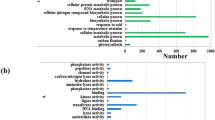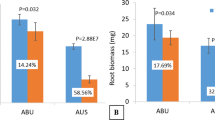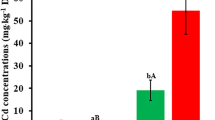Abstract
Soil acidification is one of major problems limiting crop growth and especially becoming increasingly serious in China owing to excessive use of nitrogen fertilizer. Only the STOP1 of Arabidopsis was identified clearly sensitive to proton rhizotoxicity and the molecular mechanism for proton toxicity tolerance of plants is still poorly understood. The main objective of this study was to investigate the transcriptomic change in plants under the low pH stress. The low pH as a single factor was employed to induce the response of the wheat seedling roots. Wheat cDNA microarray was used to identify differentially expressed genes (DEGs). A total of 1057 DEGs were identified, of which 761 genes were up-regulated and 296 were down-regulated. The greater percentage of up-regulated genes involved in developmental processes, immune system processes, multi-organism processes, positive regulation of biological processes and metabolic processes of the biological processes. The more proportion of down-regulation genes belong to the molecular function category including transporter activity, antioxidant activity and molecular transducer activity and to the extracellular region of the cellular components category. Moreover, most genes among 41 genes involved in ion binding, 17 WAKY transcription factor genes and 17 genes related to transport activity were up-regulated. KEGG analysis showed that the jasmonate signal transduction and flavonoid biosynthesis might play important roles in response to the low pH stress in wheat seedling roots. Based on the data, it is can be deduced that WRKY transcription factors might play a critical role in the transcriptional regulation, and the alkalifying of the rhizosphere might be the earliest response process to low pH stress in wheat seedling roots. These results provide a basis to reveal the molecular mechanism of proton toxicity tolerance in plants.





Similar content being viewed by others
References
Bewley JD, Bradford KJ, Hilhorst HWM, Nonogaki H (2013) Seeds: physiology of development, germination and dormancy, 3rd edn. Springer, New York
Bibikova TN, Jacob T, Dahse I, Gilroy S (1998) Localized changes in apoplastic and cytoplasmic pH are associated with root hair development in Arabidopsis thaliana. Development 125:2925–2934
Bose J, Babourina O, Shabala S, Rengel Z (2010) Aluminum-dependent dynamics of ion transport in Arabidopsis: specificity of low pH and aluminium responses. Physiol Plant 139:401–412
Bouche N, Fromm H (2004) GABA in plants: just a metabolite? Trends Plant Sci 9:110–115
Buer CS, Sukumar P, Muday GK (2006) Ethylene modulates flavonoid accumulation and gravitropic responses in roots of Arabidopsis. Plant Physiol 140:1384–1396
Cai Z, Wang B, Xu M, Zhang H, He X, Zhang L, Gao S (2015) Intensified soil acidification from chemical N fertilization and prevention by manure in an 18-year field experiment in the red soil of southern China. J Soil Sediment 15:260–270
Conesa A, Götz S, García-Gómez JM, Terol J, Talón M, Robles M (2005) Blast2GO: a universal tool for annotation, visualization and analysis in functional genomics research. Bioinformatics 21:3674–3676
Ding ZJ, Yan JY, Xu XY, Li GX, Zheng SJ (2013) WRKY46 functions as a transcriptional repressor of ALMT1, regulating aluminum-induced malate secretion in Arabidopsis. Plant J 76:825–835
Dixon RA, Liu C, Jun JH (2013) Metabolic engineering of anthocyanins and condensed tannins in plants. Curr Opin Biotech 24:329–335
Fan W, Lou HQ, Gong YL, Liu MY, Cao MJ, Liu Y, Yang JL, Zheng SJ (2015) Characterization of an inducible C2H2-type zinc finger transcription factor VuSTOP1 in rice bean (Vigna umbellata) reveals differential regulation between low pH and Al tolerance mechanisms. New Phytol 208:456–468
Fan W, Lou HQ, Yang JL, Zheng SJ (2016) The roles of stop1-like transcription factors in aluminum and proton tolerance. Plant Signal Behav 11:e1131371
Fang XZ, Tian WH, Liu XX, Lin XY, Jin CW, Zheng SJ (2016) Alleviation of proton toxicity by nitrate uptake specifically depends on nitrate transporter 1.1 in Arabidopsis. New Phytol 211:149–158
Furukawa J, Yamaji N, Wang H, Mitani N, Murata Y, Sato K, Katsuhara M, Takeda K, Ma JF (2007) An aluminum-activated citrate transporter in barley. Plant Cell Physiol 48:1081–1091
Futterer O, Agnelov A, Lieseqang H, Gottschalk G, Schleper C, Schepers B, Dock C, Antranikian G, Liebl W (2004) Genome sequence of Picrophilu storridus and its implications for life around pH 0. Proc Natl Acad Sci USA 101:9091–9096
Garay-Arroyo A, Ortiz-Moreno E, Sánchez MDLP, Murphy AS, García-Ponce B, Marsch-Martínez N, Folter S, Corvera-Poiré A, Jaimes-Miranda F, Pacheco-Escobedo MA et al (2013) The mads transcription factor xal2/agl14 modulates auxin transport during arabidopsis root development by regulating pin expression. EMBO J 32:2884–2895
Garcia-oliveira AL, Benito C, Prieto P, Menezes RDA, Rodrigues-Pousada C, Guedes-Pinto H, Martins-Lopes P (2013) Molecular characterization of TaSTOP1 homoeologues and their response to aluminium and proton (H+) toxicity in bread wheat (Triticum aestivum l.). BMC Plant Biol 13:1–13
Gondor OK, Janda T, Soós V, Pál M, Majláth I, Adak MK, Balázs E, Szalai G (2016) Salicylic acid induction of flavonoid biosynthesis pathways in wheat varies by treatment. Front Plant Sci 7:1447
Gracas JP, Ruiz-Romero R, Figueiredo LD, Mattiello L, Peres LEP, Vitorello VA (2016) Root growth restraint can be an acclimatory response to low pH and is associated with reduced cell mortality: a possible role of class III peroxidases and NADPH oxidases. Plant Biol 18:658–668
Guo JH, Liu XJ, Zhang Y, Shen JL, Han WX, Zhang WF, Christie P, Goulding KWT, Vitousek PM, Zhang FS (2010) Significant acidification in major Chinese croplands. Science 327:1008–1010
Hoekenga OA, Maron LG, Piñeros MA, Cançado GMA, Shaff J, Kobayashi Y, Ryan PR, Dong B, Delhaize E, Sasaki T et al (2006) AtALMT1, which encodes a malate transporter, is identified as one of several genes critical for aluminum tolerance in Arabidopsis. Proc Natl Acad Sci USA 103:9738–9743
Huang CF, Yamaji N, Mitani N, Yano M, Nagamura Y, Ma JF (2009) A bacterial-type ABC transporter is involved in aluminum tolerance in rice. Plant Cell 21:655–667
Huang J, Zhang W, Mo J, Wang S, Liu J, Chen H (2015) Urbanization in China drives soil acidification of Pinus massoniana forests. Sci Rep 5:13512
Ikka T, Kobayashi Y, Luchi S, Sakurai N, Shibata D, Kobayashi M, Koyama H (2007) Natural variation of Arabidopsis thaliana reveals that aluminum resistance and proton resistance are controlled by different genetic factors. Theor Appl Genet 115:709–719
Janda T, Gondor OK, Yordanova R, Szalai G, Pál M (2014) Salicylic acid and photosynthesis: signalling and effects. Acta Physiol Plant 36:2537–2546
Kobayashi Y, Kobayashi Y, Watanabe T, Shaff JE, Ohta H, Kochian LV, Wagatsuma T, Kinraide TB, Koyama H (2013) Molecular and physiological analysis of Al3+and H+ rhizotoxicities at moderately acidic conditions. Plant Physiol 163:180–192
Kobayashi Y, Ohyama Y, Kobayashi Y, Ito H, Iuchi S, Fujita M, Zhao CR, Tanveer T, Ganesan M, Kobayashi M et al (2014) STOP2 activates transcription of several genes for Al- and low pH-tolerance that are regulated by STOP1 in Arabidopsis. Mol Plant 7:311–322
Kochian LV, Hoekenga OA, Pineros MA (2004) How do crop plants tolerate acid soils? Mechanisms of aluminum tolerance and phosphorous efficiency. Ann Rev Plant Biol 55:459–493
Kochian LV, Pineros MA, Hoekenga OA (2005) The physiology, genetics and molecular biology of plant aluminum resistance and toxicity. Plant Soil 274:175–195
Kopittke PM, Moore KL, Lombi E, Gianoncelli A, Ferguson BJ, Blamey FPC, Menzies NW, Nicholson TM, McKenna BA, Wang P et al (2015) Identification of the primary lesion of toxic aluminum in plant roots. Plant Physiol 167:1402–1411
Koyama H, Toda T, Yotoka S, Dawair Z, Hara T (1995) Effects of aluminium and pH on root growth and cell viability in Arabidopsis thaliana strain Landsberg in hydroponic culture. Plant Cell Physiol 36:201–205
Koyama H, Toda T, Hara T (2001) Brief exposure to low-pH stress causes irreversible damage to the growing root in Arabidopsis thaliana: pectin-Ca interaction may play an important role in proton rhizotoxicity. J Exp Bot 52:361–368
Krapp A, Berthom R, Orsel M, Mercey-Boutet S, Yu A, Castaings L, Elftieh S, Major H, Renou JP, Daniel-Vedele F (2011) Arabidopsis roots and shoots show distinct temporal adaptation patterns toward nitrogen starvation. Plant Physiol 157:1255–1282
Kreps JA, Wu Y, Chang HS, Zhu T, Wang X, Harper JF (2002) Transcriptome changes for Arabidopsis in response to salt, osmotic, and cold stress. Plant Physiol 130:2129–2141
Lager I, Andreasson O, Dunbar TL, Andreasson E, Escobar MA, Rasmusson AG (2010) Changes in external pH rapidly alter plant gene expression and modulate auxin and elicitor responses. Plant Cell Environ 33:1513–1528
Larsen PB, Geisler MJ, Jones CA, Williams KM, Cancel JD (2005) ALS3 encodes a phloem-localized ABC transporter-like protein that is required for aluminum tolerance in Arabidopsis. Plant J 41:353–363
Larsen PB, Cancel J, Rounds M, Ochoa V (2007) Arabidopsis ALS1 encodes a root tip and stele localized half type ABC transporter required for root growth in an aluminum toxic environment. Planta 225:1447–1458
Lescot M, Dehais P, Moreau Y, De Moor B, Rouze P, Rombauts S (2002) PlantCARE: a database of plant cis-acting regulatory elements and a portal to tools for in silico analysis of promoter sequences. Nucleic Acids Res 30:325–327
Livak KJ, Schmittgen TD (2001) Analysis of relative gene expression data using real-time quantitative PCR and the 2–∆∆ CT method. Methods 25:402–408
Lopes MA, Larkins BA (1993) Endosperm origin, development, and function. Plant Cell 5:1383–1399
Luchi S, Koyama H, Iuchi A, Kobayashi Y, Kitabayashi S, Kobayashi Y, Ikka T, Hirayama T, Shinozaki K, Kobayashi M (2007) Zinc finger protein STOP1 is critical for proton tolerance in Arabidopsis and coregulates a key gene in aluminum tolerance. Proc Natl Acad Sci USA 104:9900–9905
Magalhaes JV, Liu J, Guimarães CT, Lana UG, Alves VM, Wang YH, Schaffert RE, Hoekenga OA, Piñeros MA, Shaff JE et al (2007) A gene in the multidrug and toxic compound extrusion (MATE) family confers aluminum tolerance in sorghum. Nat Genet 39:1156–1161
Mao QQ, Guan MY, Lu KX, Du ST, Fan SK, Ye YQ, Lin XY, Jin CW (2014) Inhibition of nitrate transporter 1.1-controlled nitrate uptake reduces cadmium uptake in Arabidopsis. Plant Physiol 166:934–944
Monshausen GB, Bibikova TN, Messerli MA, Shi C, Gilroy S (2007) Oscillations in extracellular pH and reactive oxygen species modulate tip growth of Arabidopsis root hairs. Proc Natl Acad Sci USA 104:20996–21001
Petrussa E, Braidot E, Zancani M, Peresson C, Bertolini A, Patui S, Angelo V (2013) Plant flavonoids-biosynthesis, transport and involvement in stress responses. Int J Mol Sci 14:14950–14973
Rangel AF, Mobin M, Rao IM, Horst WJ, (2005) Proton toxicity interferes with the screening of common bean (Phaseolus vulgaris L.) genotypes for aluminium resistance in nutrient solution. J Plant Nutr Soil Sci 168(4):607–616
Reyes-Díaz M, Ulloa-Inostroza EM, González-Villagra J, Ivanov AG, Kurepin LV (2016) Phytohormonal responses to soil acidity in plants. Plant hormones under challenging environmental factors. Springer, Netherlands, pp 133–155
Reyna-Llorens I, Corrales I, Poschenrieder C, Barcelo J, Cruz-Ortega R (2015) Both aluminum and ABA induce the expression of an ABC-like transporter gene (FeALS3) in the Al-tolerant species fagopyrum esculentum. Environ Exper Bot 111:74–82
Rice KC, Herman JS (2012) Acidification of earth: an assessment across mechanisms and scales. Appl Geochem 27:1–14
Ryan PR, Raman H, Gupta S, Horst WJ, Delhaize E (2009) A second mechanism for aluminum resistance in wheat relies on the constitutive efflux of citrate from roots. Plant Physiol 149:340–351
Sasaki T, Yamamoto Y, Ezaki B, Katsuhara M, Ahn SJ, Ryan PR, Delhaize E, Matsumoto H (2004) A wheat gene encoding an aluminum-activated malate transporter. Plant J 37:645–653
Sasaki T, Tsuchiya Y, Ariyoshi M, Ryan PR, Yamamoto Y (2016) A chimeric protein of aluminum-activated malate transporter generated from wheat and Arabidopsis shows enhanced response to trivalent cations. Biochim Biophys Acta 1858:1427–1435
Sawaki Y, Iuchi S, Kobayashi Y, Kobayashi Y, Ikka T, Sakurai N, Fujita M, Shinozaki K, Shibata D, Kobayashi M et al (2009) STOP1 regulates multiple genes that protect Arabidopsis from proton and aluminum toxicities. Plant Physiol 150:281–294
Shen H, Ligaba A, Yamaguchi M, Osawa H, Shibata K, Yan X, Matsumoto H (2004) Effect of K-252a and abscisic acid on the efflux of citrate from soybean roots. J Exp Bot 55:663–671
Tanimoto E, Fujii S, Yamamoto R, Inanaga S (2000) Measurement of viscoelastic properties of root cell walls affected by low pH in lateral roots of Pisumsativum L. Plant Soil 226:21–28
Vitorello VA, Capaldi FR, Stefanuto VA (2005) Recent advances in aluminum toxicity and resistance in higher plants. Braz J Plant Physiol 17:129–143
Wu P, Ma L, Hou X, Wang M, Wu Y, Liu F, Deng XW (2003) Phosphate starvation triggers distinct alterations of genome expression in Arabidopsis roots and leaves. Plant Physiol 13:1260–1271
Xia J, Yamaji N, Kasai T, Ma JF (2011) Plasma membrane-localized transporter for aluminum in rice. Proc Natl Acad Sci USA 107:18381–18385
Yamaji N, Huang CF, Nagao S, Yano M, Sato Y, Nagamura Y, Ma JF (2009) A zinc finger transcription factor ART1 regulates multiple genes implicated in aluminum tolerance in rice. Plant Cell 21:3339–3349
Yan D, Catalina D, Leoveanu C, Nambara E (2014) The functions of the endosperm during seed germination. Plant Cell Physiol 55:1521–1533
Yang JL, Zheng SJ, He YF, Matsumoto H (2005) Aluminium resistance requires resistance to acid stress: a case study with spinach that exudes oxalate rapidly when exposed to Al stress. J Exp Bot 56:1197–1203
Yeh CM, Ohme-Takagi M (2015) Transcription factors involved in acid stress responses in plants. Nucleus 58:191–197
Zhang H, Wu Z, Suo Y, Wang J, Zheng L, Wang Y (2017) Gene expression and flavonol biosynthesis are induced by ultraviolet-B and salt stresses in Reaumuria trigyna. Biol Plant 61:246–254
Zhou J, Fang X, Liu XM, He Y, Xu JM, Brookes PC (2014) Effects of nitrogen fertilizer on the acidification of two typical acid soils in South China. J Soils Sediment 14:415–422
Acknowledgements
This study was funded by Science and Technology Program of Henan Province, China (Grant No. 142102110041). Project supported by the State Key Development Program for Research of China (Grant No. 2017YFD0100705).
Author information
Authors and Affiliations
Corresponding authors
Ethics declarations
Conflict of interest
Haiyan Hu, Jie He, Junjie Zhao, Xingqi Ou, Hongmin Li and Zhengang Ru declare that they have no conflict of interest.
Ethical approval
This article does not contain any studies with human subjects or animals performed by any of the authors.
Electronic supplementary material
Below is the link to the electronic supplementary material.
Rights and permissions
About this article
Cite this article
Hu, H., He, J., Zhao, J. et al. Low pH stress responsive transcriptome of seedling roots in wheat (Triticum aestivum L.). Genes Genom 40, 1199–1211 (2018). https://doi.org/10.1007/s13258-018-0680-6
Received:
Accepted:
Published:
Issue Date:
DOI: https://doi.org/10.1007/s13258-018-0680-6




